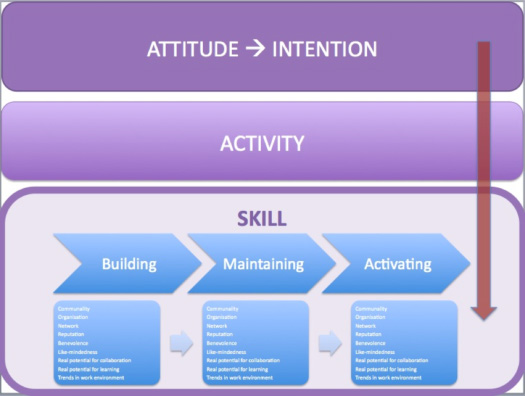What are Personal Learning Networks (PLNs)?
A Personal Learning Network (PLN) is a learning web where an individual intentionally engages in communication, creation, and the sharing of knowledge, experiences, and resources with others connected (Future Learn, n.d.; Rajagopal et al., 2011). PLNs provide personal and professional development opportunities and the creation of a network of people, social media resources, knowledge, and professional sources that are specific to an individual’s interests and needs (Hirschy, 2016). A networked individual can contribute toward a networked society, but in doing so can also affect their digital identity (online representation) and the way they learn, communicate, study, and work (Future Learn, n.d.). Through the development of these networks and technologies such as internet, smartphones, social media, etc., people have gained access to easier communication and a wealth of knowledge and connections in society that contribute to continual learning, growth, and opportunities.
What does it mean to network using social media?
Before technology and the internet, networking, the process of exchanging information with others and developing professional or social contacts (Oxford Learner’s Dictionaries, n.d.), was limited to in-person, a more irregular, restrictive communication. The development and use of social media (Twitter, LinkedIn, Facebook, Instagram, WhatsApp, blogs, etc.) for networking has further facilitated easier connection to others including relieving the restrictions imposed by time zones and location (Gutierrez, n.d.). By using social media to network, individuals can instantly search and engage with others allowing for new opportunities for connections and knowledge that otherwise may not have been possible.
How are we motivated to participate in networked publics?
Rajagopal et al. (2011) state that networking is linked to a deeper metacognitive level based on the attitude of the individual. They describe the Personal Professional Learning Network Model, a three-layered model that briefly describes the progression of a learner’s attitude into their actions, with two important intermediary steps:
- Translation of attitude into intention – intentionally building their contacts based on their attitude.
- Translation of intention into actions – engages in practices enabling and supporting networks.
Thus, the attitude of the individual is crucial for reaping the benefits of networked publics and PLNs: the evident convenience and accessibility of participation/communication available in a timely fashion. In the age of COVID-19, the ability to connect to others who live and work remotely, easily follow others’ developments, share thoughts/opinions/knowledge, attend workshops/lectures/conferences live-streamed from the comfort of home, improve social competencies, and access to instant help and advice has proven advantageous, especially with the little-to-no financial cost and usefulness of tools/aids such as social media (Gutierrez, n.d.).
What are the risks & rewards of public communications?
| Risks | Rewards (*for additional information read above) |
|---|---|
| Privacy Infringements – social engineering, data security breaches, phishing, viruses, and malware can be concerns – as with any online activities, unauthorized access to disclosed personal information may lead to reputational risk, bullying, etc. (Khan, 2017). | Connection Building –increased accessibility to knowledge, resources, support, etc. with reduced barriers including time and location. Social Media can provide a broader source of resources/contacts/opinions than otherwise possible through in-person only networking. |
| Lack of Control – by following privacy settings, permissions, and guidelines, some may have to censor material they wanted to share; additionally, strangers can also post pictures or other media containing sensitive information without an individual’s consent (Boyd, 2012). Online resources are virtually limitless – it takes focus/discipline to not be led down a rabbit hole of worthless information. Also, not all posted information is reliable – aka “fake news.” | Professional/Personal Development & PLN expansion – supports the development and growth of a career. Gain opportunities to connect with relevant people both professionally and personally (Rajagopal et al., 2011). |
| Categorization and Comparison – use of online algorithms and AI collect data about the user; while this may be beneficial for personalization, it may also often lead to the categorization of individuals that predict interests based on others’ habits and have negative impacts – how technology sees us may depend on how we are subsequently connected to others (Boyd, 2012). | Contribution to the community – by involving oneself in public communication, one is not only personally benefiting themself, but the others they are communicating with too. Self-fulfilling. |
What can be done to minimize risks and maximize rewards?
- Guidelines (Khan, 2017) – follow guidelines implemented by the social media sites and subject matter experts on this topic. To some extent, censoring information and limiting what is shared publicly should be encouraged.
- Training and Awareness (Khan, 2017) – proper use of social media and related tools, and mindfulness with one’s online presence and engagement. Don’t believe everything you read – do your own fact-checking.
Moving Forward: My challenge to you, the reader.
I encourage you to develop your networking skills and find valuable social networks for your own proficiencies and personal/professional development: discover interests, share passions, learn, and communicate with like-minded individuals. The references cited below offer more guidance on the topic.
References
Boyd, D. (2012). Networked Privacy. Surveillance & Society, 10(3/4). https://doi.org/10.24908/ss.v10i3/4.4529
Future Learn. (n.d.). What is a personal learning network (PLN)? https://www.futurelearn.com/info/courses/learning-network-age/0/steps/24644
Gutierrez, K. (n.d.). What are personal learning networks? Shift eLearning. https://www.shiftelearning.com/blog/personal-learning-networks
Hirschy, S.T. (2016). Creating a Personalized Learning Network for Professional Development and Growth. Exchange. https://dcf.wisconsin.gov/files/ccic/pdf/articles/creating-a-personalized-learning-network.pdf
Khan, M. J. (2017). Social media rewards and risks. ISACA Journal, 4, 1-5. https://www.isaca.org/resources/isaca-journal/issues/2017/volume-4/social-media-rewards-and-risk
Oxford Learner’s Dictionaries. (n.d.). Network definition. https://www.oxfordlearnersdictionaries.com/definition/english/network_1
Rajagopal, K., Joosten-ten Brinke, D., Van Bruggen, J., & Sloep, P. J. (2011). Understanding personal learning networks: Their structure, content, and the networking skills needed to optimally use them. First Monday, 17(1). https://doi.org/10.5210/fm.v17i1.3559


Leave a Reply